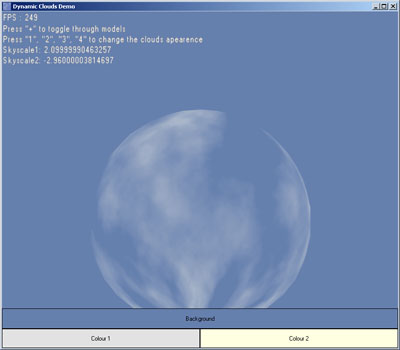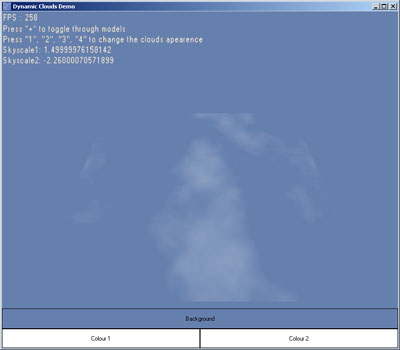|
Aktuelle Zeit: Sa Dez 20, 2025 03:30 Foren-Übersicht » English » English Programming Forum |
Unbeantwortete Themen | Aktive Themen |
Dynamic Clouds Demo
Moderator: DGL-Team
|
|
Seite 1 von 2 |
[ 22 Beiträge ] | Gehe zu Seite 1, 2 Nächste |
|
| Autor | Nachricht | |||||
|---|---|---|---|---|---|---|
| Stucuk |
|
|||||
Registriert: Mi Jul 21, 2004 22:39 Beiträge: 360 Wohnort: UK, Scotland |
|
|||||
| Nach oben | ||||||
| Flash |
|
|||||
Registriert: Do Sep 25, 2003 15:56 Beiträge: 7810 Wohnort: Sachsen - ERZ / C Programmiersprache: Java (, Pascal) |
|
|||||
| Nach oben | ||||||
| MatReno |
|
|||||
Registriert: Mo Jan 31, 2005 11:02 Beiträge: 432 Wohnort: Rheinlandpfalz |
|
|||||
| Nach oben | ||||||
| Stucuk |
|
|||||
Registriert: Mi Jul 21, 2004 22:39 Beiträge: 360 Wohnort: UK, Scotland |
|
|||||
| Nach oben | ||||||
| Lord Horazont |
|
|||||
Registriert: Do Sep 02, 2004 19:42 Beiträge: 4158 Programmiersprache: FreePascal, C++ |
|
|||||
| Nach oben | ||||||
| noeska |
|
|||||
Registriert: Di Jul 01, 2003 18:59 Beiträge: 887 Wohnort: (The Netherlands) Programmiersprache: fpc/delphi/java/c# |
|
|||||
| Nach oben | ||||||
| Traude |
|
||||||
Registriert: Di Okt 03, 2006 14:07 Beiträge: 1277 Wohnort: Wien |
|
||||||
| Nach oben | |||||||
| Stucuk |
|
|||||
Registriert: Mi Jul 21, 2004 22:39 Beiträge: 360 Wohnort: UK, Scotland |
|
|||||
| Nach oben | ||||||
| Stucuk |
|
|||||
Registriert: Mi Jul 21, 2004 22:39 Beiträge: 360 Wohnort: UK, Scotland |
|
|||||
| Nach oben | ||||||
| The-Winner |
|
||||
Registriert: Di Jun 06, 2006 09:59 Beiträge: 474 |
|
||||
| Nach oben | |||||
| Lord Horazont |
|
|||||
Registriert: Do Sep 02, 2004 19:42 Beiträge: 4158 Programmiersprache: FreePascal, C++ |
|
|||||
| Nach oben | ||||||
| Traude |
|
|||||
Registriert: Di Okt 03, 2006 14:07 Beiträge: 1277 Wohnort: Wien |
|
|||||
| Nach oben | ||||||
| Stucuk |
|
|||||
Registriert: Mi Jul 21, 2004 22:39 Beiträge: 360 Wohnort: UK, Scotland |
|
|||||
| Nach oben | ||||||
| Lord Horazont |
|
|||||
Registriert: Do Sep 02, 2004 19:42 Beiträge: 4158 Programmiersprache: FreePascal, C++ |
|
|||||
| Nach oben | ||||||
| Stucuk |
|
|||||
Registriert: Mi Jul 21, 2004 22:39 Beiträge: 360 Wohnort: UK, Scotland |
|
|||||
| Nach oben | ||||||
|
|
Seite 1 von 2 |
[ 22 Beiträge ] | Gehe zu Seite 1, 2 Nächste |
Wer ist online? |
Mitglieder in diesem Forum: 0 Mitglieder und 12 Gäste |
| Du darfst keine neuen Themen in diesem Forum erstellen. Du darfst keine Antworten zu Themen in diesem Forum erstellen. Du darfst deine Beiträge in diesem Forum nicht ändern. Du darfst deine Beiträge in diesem Forum nicht löschen. Du darfst keine Dateianhänge in diesem Forum erstellen. |


